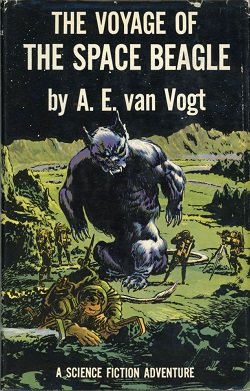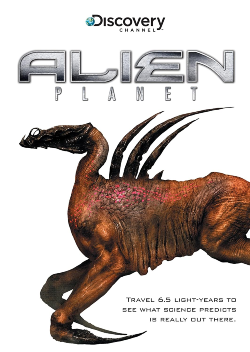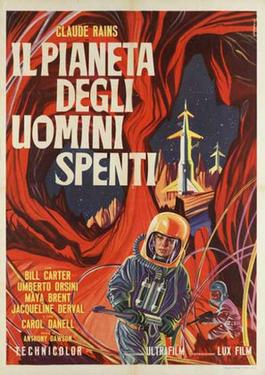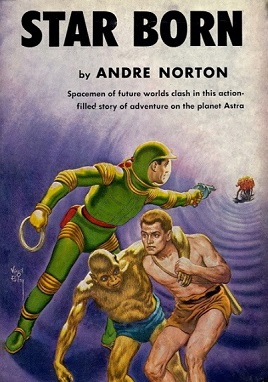
Extraterrestrial life, alien life, or colloquially simply aliens is life which does not originate from Earth. No extraterrestrial life has yet been conclusively detected. Such life might range from simple forms such as prokaryotes to intelligent beings, possibly bringing forth civilizations that might be far more advanced than humanity. The Drake equation speculates about the existence of sapient life elsewhere in the universe. The science of extraterrestrial life is known as astrobiology.
Who Goes There? is a 1938 science fiction horror novella by American author John W. Campbell, written under the pen name Don A. Stuart. Its story follows a group of people trapped in a scientific outpost in Antarctica infested by shapeshifting monsters able to absorb and perfectly imitate any living being, including humans. Who Goes There? was first published in the August 1938 issue of Astounding Science Fiction magazine and was also printed as The Thing from Another World, as well as included in the collection by the same title. Its extended, novel version, found in an early manuscript titled Frozen Hell, was finally published in 2019.

A humanoid is a non-human entity with human form or characteristics. By the 20th century, the term came to describe fossils which were morphologically similar, but not identical, to those of the human skeleton.

Alienators: Evolution Continues is an animated comic science fiction television series. It is a continuation of the 2001 Ivan Reitman science fiction film, Evolution. 26 episodes were produced.

The Voyage of the Space Beagle (1950) is a science fiction novel by Canadian-American writer A. E. van Vogt. An example of space opera subgenre, the novel is a "fix-up" compilation of four previously published stories:
Wayne Douglas Barlowe is an American science fiction and fantasy writer, painter, and concept artist. Barlowe's work focuses on esoteric landscapes and creatures such as citizens of hell and alien worlds. He has painted over 300 books, magazine covers and illustrations for many major book publishers, as well as Life magazine, Time magazine, and Newsweek. His 1979 book Barlowe's Guide to Extraterrestrials was nominated in 1980 for the Hugo Award for Best Related Non-Fiction Book, the first year that award category was awarded. It also won the 1980 Locus Award for Best Art or Illustrated Book. His 1991 speculative evolution book Expedition was nominated for the 1991 Chesley Award for Artistic Achievement.

An extraterrestrial or alien is any extraterrestrial lifeform: a lifeform that did not originate on Earth. The word extraterrestrial means "outside Earth". The first published use of extraterrestrial as a noun occurred in 1956, during the Golden Age of Science Fiction.

Mission of Gravity is a science fiction novel by American writer Hal Clement. The novel was serialized in Astounding Science Fiction magazine in April–July 1953. Its first hardcover book publication was in 1954, and it was first published as a paperback book in 1958. Along with the novel, many editions of the book also include "Whirligig World", an essay by Clement on creating the planet Mesklin that was first published in the June 1953 Astounding.

Alien Planet is a 2005 docufiction TV special created for the Discovery Channel. Based on the 1990 book Expedition by the artist and writer Wayne Barlowe, Alien Planet explores the imagined extraterrestrial life of the fictional planet Darwin IV in the style of a nature documentary. Although closely following Barlowe's depiction of Darwin IV, Alien Planet features a team of scientists and science fiction figures discussing Darwin IV as if it had actually been discovered. Among the people featured are Michio Kaku, Stephen Hawking, Jack Horner, James B. Garvin and George Lucas.

Jupiter, the largest planet in the Solar System, has appeared in works of fiction across several centuries. The way the planet has been depicted has evolved as more has become known about its composition; it was initially portrayed as being entirely solid, later as having a high-pressure atmosphere with a solid surface underneath, and finally as being entirely gaseous. It was a popular setting during the pulp era of science fiction. Life on the planet has variously been depicted as identical to humans, larger versions of humans, and non-human. Non-human life on Jupiter has been portrayed as primitive in some works and more advanced than humans in others.

Saturn has made appearances in fiction since the 1752 novel Micromégas by Voltaire. In the earliest depictions, it was portrayed as having a solid surface rather than its actual gaseous composition. In many of these works, the planet is inhabited by aliens that are usually portrayed as being more advanced than humans. In modern science fiction, the Saturnian atmosphere sometimes hosts floating settlements. The planet is occasionally visited by humans and its rings are sometimes mined for resources.

Wheelers is a hard science fiction novel written by English mathematician Ian Stewart and reproductive biologist Jack Cohen. The book was originally released in hardcover form in the year 2000, and a more common paperback printing was begun in 2001. It has enjoyed modest commercial success and is perhaps best known for its conceptions of alien zoology and intelligence—hallmarks of Cohen's work as a consultant on exobiology for books, movies, and television.

Battle of the Worlds is a 1961 Italian science fiction film directed by Anthony Dawson. The film stars Claude Rains, Bill Carter, and Maya Brent.

The Viagens Interplanetarias series is a sequence of science fiction stories by L. Sprague de Camp, begun in the late 1940s and written under the influence of contemporary space opera and sword and planet stories, particularly Edgar Rice Burroughs's Martian novels. Set in the future in the 21st and 22nd centuries, the series is named for the quasi-public Terran agency portrayed as monopolizing interstellar travel, the Brazilian-dominated Viagens Interplanetarias. It is also known as the Krishna series, as the majority of the stories belong to a sequence set on a fictional planet of that name. While de Camp started out as a science fiction writer and his early reputation was based on his short stories in the genre, the Viagens tales represent his only extended science fiction series.

Star Born is a science fiction novel by American writer Andre Norton, first published in 1957 by World Publishing Company of Cleveland. As the sequel to The Stars Are Ours!, Star Born continues its predecessor's adventure three generations later.
Speculative evolution is a subgenre of science fiction and an artistic movement focused on hypothetical scenarios in the evolution of life, and a significant form of fictional biology. It is also known as speculative biology and it is referred to as speculative zoology in regards to hypothetical animals. Works incorporating speculative evolution may have entirely conceptual species that evolve on a planet other than Earth, or they may be an alternate history focused on an alternate evolution of terrestrial life. Speculative evolution is often considered hard science fiction because of its strong connection to and basis in science, particularly biology.
A self-replicating machine is a type of autonomous robot that is capable of reproducing itself autonomously using raw materials found in the environment, thus exhibiting self-replication in a way analogous to that found in nature. Such machines are often featured in works of science fiction.

Biology appears in fiction, especially but not only in science fiction, both in the shape of real aspects of the science, used as themes or plot devices, and in the form of fictional elements, whether fictional extensions or applications of biological theory, or through the invention of fictional organisms. Major aspects of biology found in fiction include evolution, disease, genetics, physiology, parasitism and symbiosis (mutualism), ethology, and ecology.

Snaiad is a speculative evolution, science fiction and artistic worldbuilding project by Turkish artist C. M. Kösemen, focused on a fictional exoplanet of the same name. Begun in the early 2000s and inspired by earlier works such as Wayne Barlowe's 1990 book Expedition, Kösemen has produced hundreds of paintings and sketches of creatures of Snaiad, with detailed ecological roles and taxonomic relationships to each other. The sheer number of invented creatures and lineages makes Snaiad one of the most biologically diverse fictional worlds.

The following outline is provided as an overview of and topical guide to extraterrestrial life:
















